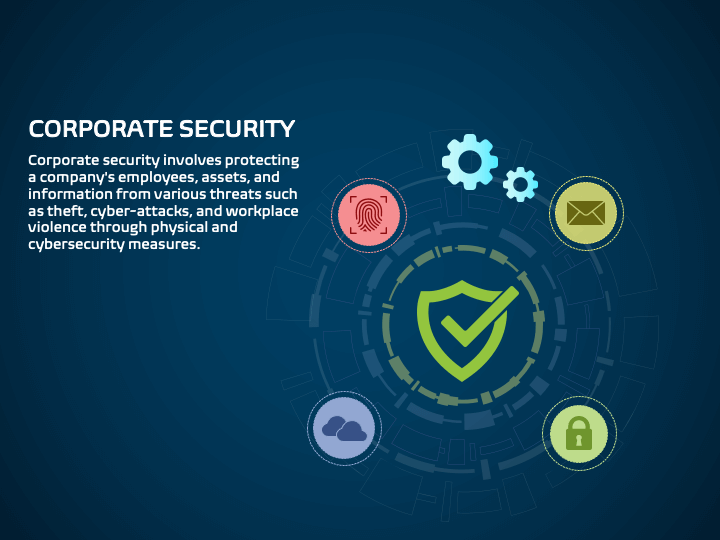From Cybersecurity to Physical Measures: Enhancing Company Security in an Altering World
By integrating the toughness of both cybersecurity and physical safety, firms can develop an extensive defense strategy that resolves the diverse array of hazards they face. In this conversation, we will certainly explore the transforming danger landscape, the demand to incorporate cybersecurity and physical security, the implementation of multi-factor authentication actions, the importance of staff member awareness and training, and the adaptation of safety steps for remote labor forces. By taking a look at these vital areas, we will acquire valuable insights right into exactly how companies can enhance their corporate safety and security in an ever-changing world.
Recognizing the Transforming Danger Landscape
The developing nature of the contemporary world demands a detailed understanding of the transforming danger landscape for efficient corporate security. In today's digital and interconnected age, dangers to company protection have become much more complicated and innovative. As modern technology developments and services come to be progressively dependent on electronic facilities, the possibility for cyberattacks, information violations, and various other protection violations has significantly boosted. It is essential for companies to remain informed and adjust their security determines to resolve these developing threats.
One key aspect of comprehending the altering danger landscape is identifying the different sorts of dangers that companies deal with. Cybercriminals are continuously establishing new strategies to manipulate susceptabilities in computer systems and networks. These hazards can vary from malware and ransomware strikes to phishing scams and social engineering methods. Additionally, physical risks such as burglary, vandalism, and business reconnaissance stay prevalent concerns for companies.
Tracking and evaluating the danger landscape is necessary in order to determine prospective threats and susceptabilities. This involves remaining updated on the current cybersecurity trends, assessing risk intelligence records, and carrying out normal danger analyses. By comprehending the altering hazard landscape, companies can proactively apply ideal protection actions to alleviate threats and shield their properties, credibility, and stakeholders.
Integrating Cybersecurity and Physical Security
Integrating cybersecurity and physical safety is crucial for extensive company protection in today's interconnected and digital landscape. As organizations increasingly rely upon innovation and interconnected systems, the limits between physical and cyber threats are coming to be blurred. To effectively protect versus these risks, a holistic approach that combines both cybersecurity and physical protection steps is important.
Cybersecurity concentrates on shielding electronic properties, such as networks, information, and systems, from unauthorized access, disturbance, and theft. Physical safety and security, on the various other hand, includes actions to safeguard physical possessions, individuals, and centers from vulnerabilities and risks. By integrating these two domain names, companies can address vulnerabilities and risks from both digital and physical angles, thereby improving their overall safety stance.
The assimilation of these two self-controls enables for a much more thorough understanding of safety and security risks and allows a unified feedback to occurrences. Physical accessibility controls can be improved by integrating them with cybersecurity protocols, such as two-factor verification or biometric identification. Cybersecurity steps can be complemented by physical safety procedures, such as monitoring cameras, alarms, and protected access points.

Carrying Out Multi-Factor Authentication Measures
As companies increasingly prioritize extensive safety and security steps, one effective technique is the application of multi-factor verification actions. Multi-factor authentication (MFA) is a safety and security approach that calls for individuals to give numerous forms of identification to access a system or application. This method adds an extra layer of security by incorporating something the individual understands, such as a password, with something they have, like a safety or a finger print token.
By applying MFA, organizations can considerably improve their safety stance - corporate security. Traditional password-based verification has its restrictions, as passwords check here can be quickly endangered or forgotten. MFA mitigates these dangers by including an added authentication aspect, making it a lot more tough for unauthorized individuals to get to sensitive info
There are a number of kinds of multi-factor authentication methods available, including biometric verification, SMS-based verification codes, and equipment tokens. Organizations require to examine check these guys out their certain needs and choose one of the most appropriate MFA remedy for their needs.
Nevertheless, the application of MFA must be meticulously intended and carried out. It is critical to strike a balance between security and usability to stop individual stress and resistance. Organizations should likewise think about prospective compatibility concerns and provide appropriate training and support to guarantee a smooth shift.
Enhancing Worker Recognition and Training
To reinforce business safety, organizations need to focus on boosting staff member awareness and training. Numerous safety and security violations happen due to human mistake or lack of understanding.
Effective worker understanding and training programs need to cover a wide variety of topics, consisting of data defense, phishing strikes, social engineering, password hygiene, and physical protection procedures. These programs need to be tailored to the details requirements and obligations of different employee functions within the company. Regular training sessions, simulations, and workshops can aid workers establish the necessary skills and expertise to recognize and react to protection dangers efficiently.
In addition, companies must urge a culture of protection understanding and supply continuous updates and reminders to keep employees notified regarding the newest hazards and mitigation strategies. This can be done with internal interaction channels, such as newsletters, intranet portals, and e-mail projects. By fostering a security-conscious workforce, organizations can significantly lower the chance of security occurrences and protect their important possessions from unapproved accessibility or concession.

Adapting Safety Steps for Remote Workforce
Adapting corporate protection procedures to fit a remote workforce is vital in guaranteeing the defense of sensitive info and possessions (corporate security). With the raising pattern of remote work, companies must execute proper protection measures to minimize the dangers connected with this brand-new method of functioning
One crucial facet of adjusting security steps for remote work is establishing protected interaction networks. Encrypted messaging systems and digital exclusive networks (VPNs) can assist protect delicate details and stop unauthorized access. Furthermore, companies ought to impose using solid passwords and multi-factor authentication to enhance the safety and security of remote gain access to.
Another essential factor to consider is the implementation of secure remote accessibility services. This involves supplying employees with safe and secure access to company resources and information through digital desktop computer framework (VDI), remote desktop procedures (RDP), or cloud-based services. These technologies make certain that delicate info stays protected while making it possible for staff members to execute their duties efficiently.

Finally, thorough safety and security recognition training is crucial for remote staff members. Training sessions should cover finest practices for securely accessing and dealing with sensitive info, recognizing and reporting phishing efforts, and keeping the general cybersecurity health.
Verdict
In conclusion, as the hazard landscape proceeds to develop, it is critical for organizations to enhance their safety gauges both in the cyber and physical domain names. Integrating cybersecurity and physical safety, carrying out multi-factor verification procedures, and improving Learn More staff member recognition and training are crucial actions in the direction of achieving durable company safety and security.
In this conversation, we will explore the transforming danger landscape, the requirement to incorporate cybersecurity and physical safety, the application of multi-factor authentication steps, the significance of staff member awareness and training, and the adaptation of security measures for remote labor forces. Cybersecurity measures can be complemented by physical safety actions, such as security cameras, alarms, and safe access points.
As companies increasingly prioritize extensive safety and security actions, one efficient approach is the implementation of multi-factor authentication measures.In final thought, as the threat landscape proceeds to advance, it is essential for companies to reinforce their safety gauges both in the cyber and physical domains. Incorporating cybersecurity and physical protection, carrying out multi-factor authentication procedures, and boosting worker awareness and training are essential steps towards achieving robust corporate safety.